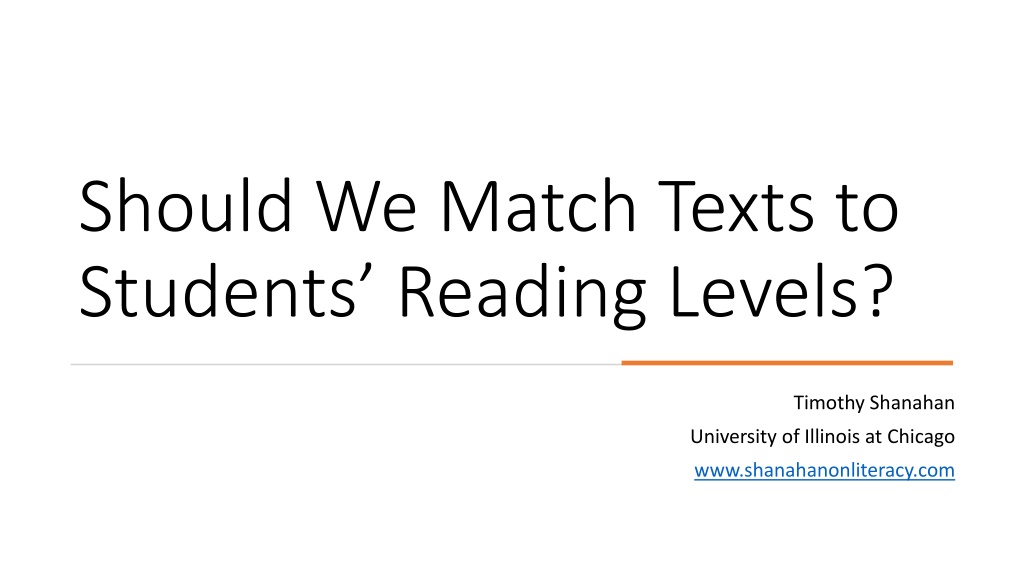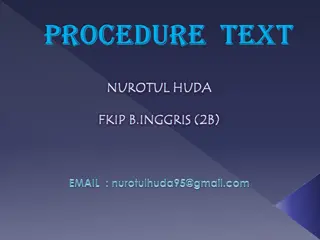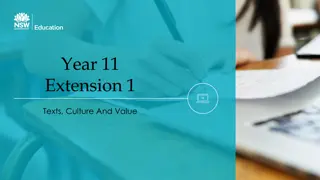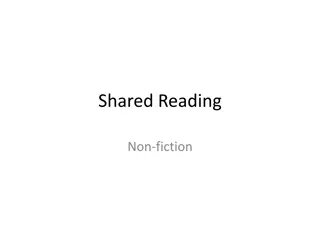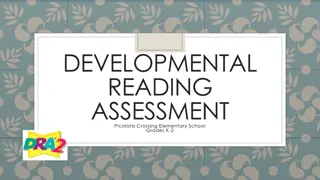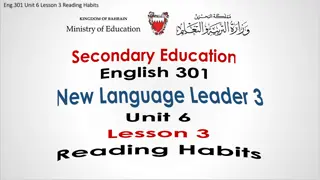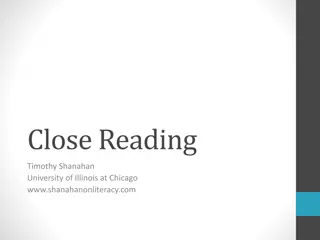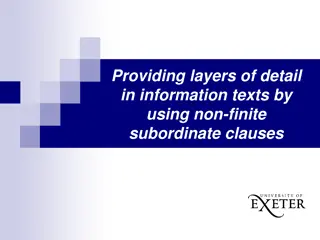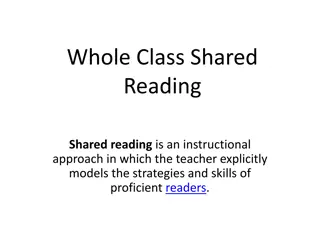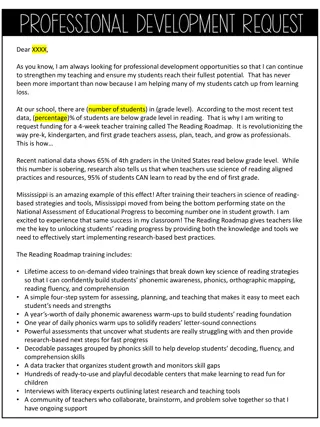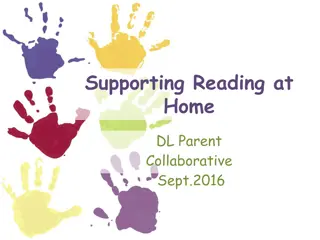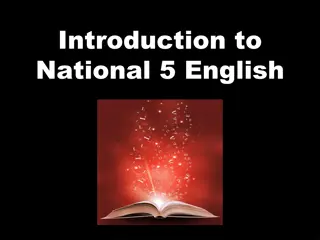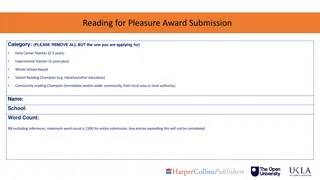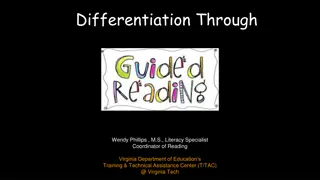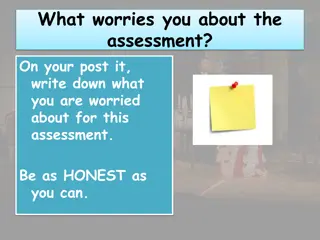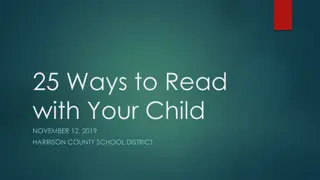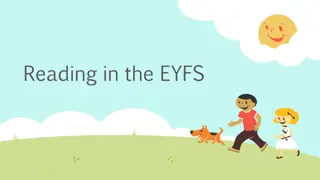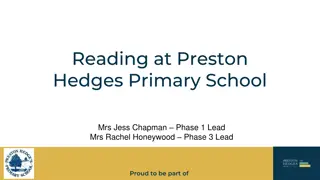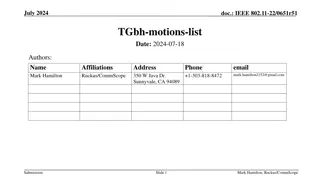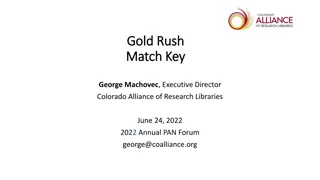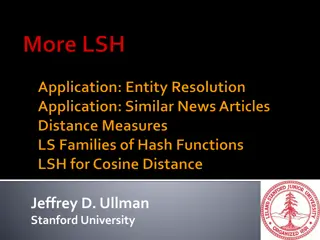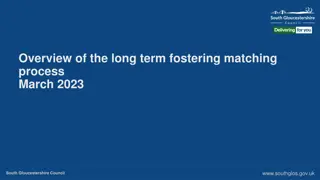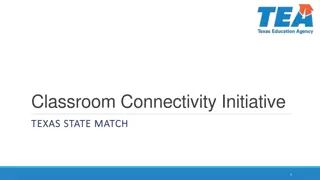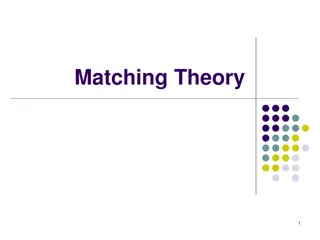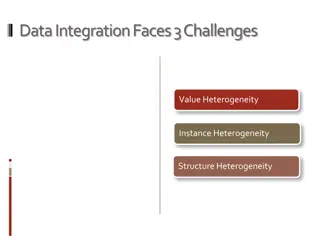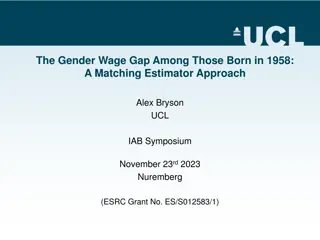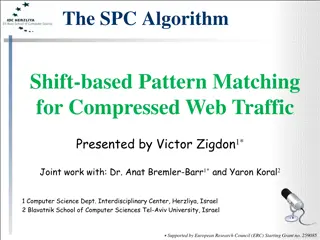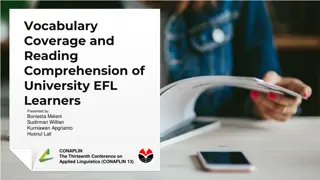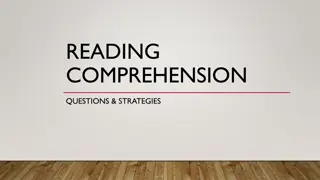Reconsidering the Matching of Texts to Students' Reading Levels
The prevailing belief that instructional materials should be tailored to students' reading levels to enhance learning may not be as effective as commonly thought. Contrary to this idea, evidence suggests that such text placements can hinder rather than facilitate student reading achievement. The historical background of instructional level placement reveals a shift in educational philosophies over time. This critical examination challenges the long-standing theory, indicating the need for a reevaluation of instructional practices in literacy education.
Download Presentation

Please find below an Image/Link to download the presentation.
The content on the website is provided AS IS for your information and personal use only. It may not be sold, licensed, or shared on other websites without obtaining consent from the author. Download presentation by click this link. If you encounter any issues during the download, it is possible that the publisher has removed the file from their server.
E N D
Presentation Transcript
Should We Match Texts to Students Reading Levels? Timothy Shanahan University of Illinois at Chicago www.shanahanonliteracy.com
Basic Premise Few instructional claims about reading have been as widely accepted for a long as the idea that students have instructional levels and that instructional materials should be matched to these levels to optimize learning ILA Literacy Glossary defines instructional level as the level of text difficulty at which a reader benefits from instructional scaffolds that support the development of reading competencies such as comprehension, decoding, or fluency. Basically, the idea is that students will make optimum progress if taught at the instructional level and if taught with easier texts (independent level) or more challenging ones (frustration level) less learning will accrue
Basic Premise (cont.) The logic model of the instructional level is: 1. High levels of fluency and comprehension will allow students to stay engaged with texts; 2. Students will not be frustrated by these placements so they will not be off task and present behavioral problems; 3. Students will make gradual progress in small increments with a minimum of teacher guidance and support.
Basic Premise (cont.) My contention is that this long-standing theory is incorrect at least across a wide swath of student performance levels, text levels, and instructional conditions Evidence does not support the claim that the instructional level facilitates student reading achievement In fact, instructional level text placements are more likely to impede students advancement in learning to read than to expedite it
History of Instructional Level (1800s) The idea of the instructional level didn t emerge until the beginning of the 20th century) References to student book placement were rare but consistent in 19thcentury normal school textbooks, professional journals, and in histories of the period Educators of that time favored the idea that students need be placed in texts they could easily understand (without too many unknown words) The basic purpose for this was to maintain student interest in the hope that this would reduce disciplinary problems for the teacher (a major concern)
History of Instructional Level (1900s) (cont.) This changes during the early 20thcentury probably due to a series of changes in the public and pedagogic contexts Massive immigration, child labor laws, urban migration, and compulsory education conspire to create classes with larger and more diverse enrollments than teachers had previously encountered Two major ideas in the psychology of the time: (1) readiness theories of learning (2) tests can identify readiness and that the scientific data drawn from testing will allows us to deal with diversity (G. Stanley Hall, 1890s - )
History of Instructional Level (1900s) (cont.) In 1918, Laura Zirbes wrote that previously educators had attempted to reduce variability by trying to force exceptional students to keep pace with the class. Each lesson was gauged to average ability, and extra attention was given to the least capable members of the class. The progress as a unit was the aim of instruction. (p. 505) She went on to argue for classes divided into groups based on standardized oral and silent reading tests, with different groups working with different sets of texts, different supplementary reading opportunities, and different skills lessons
History of Instructional Level (1900s) (cont.) How widespread such practices were is unknown, but we have a survey of Wisconsin teachers from that time (Theisen, 1920) 58% of primary grade teachers and 39% of intermediate teachers arranged students in small groups by ability 42% of primary grade teachers assigned readings on the basis of ability, as did 32% of intermediate teachers The particular merit of grouping on the basis of ability is that it permits gradation of materials . Gradation of materials furnishes an important means of providing for differences in ability. The aim here is to allow each pupil to read material suited to his development. (p. 564)
History of Instructional Level (1900s) (cont.) The idea of students possessing measurable instructional levels that would determine the appropriate level of books that they could learn from grew gradually over the next few decades For example, in an Ohio State Department of Education Guide for educators, Getting the Primary Reading Program Under Way (1933), instructional level was defined as the highest reading level at which systematic instruction can be initiated effectually For frustration levels it indicated that if students mispronounced 10% of the words in a text, then they should be moved to easier materials for instruction
History of Instructional Level (1900s) (cont.) The education literature from 1920-1945 is replete with schemes for imposing homogeneous groupings on diverse classrooms using IQ, mental ages, reading rates, standardized test scores, oral reading performance Mankato Plan, Albany Plan, Elmwood City Plan, Joplin Plan, etc. Major researchers in the field advocated the idea (e.g., Thorndike, Durrell, Dolch, Gates, Gray, Hildreth, Albert J. Harris, Monroe, Witty) Surveys showed that teachers preferred homogeneous grouping because of its effectiveness, motivational value, and positive impact on discipline (Barthelme & Bayer, 1932) Behaviorism was emphasizing high accuracy learning in which students potential frustration was severely limited
Betts Instructional Level Plan Emmett Betts published Foundations of Reading Instruction in 1946 which operationalized the idea of independent, instructional and frustration levels His basic theoretical claim was: Maximum development may be expected when the learner is challenged but not frustrated. (p. 448) His plan allows use of the informal reading inventory to determine a student s independent, instructional, and frustration levels He attributed the validation of this scheme to an unpublished doctoral dissertation (Killgallon, 1941): Among Dr. Killgallon s conclusions, this is pertinent: On the average, the ratio of word perception errors to the number of running words at the instructional level is one to twenty. (p. 445)
Betts Instructional Level Plan (cont.) Killgallon (1941) tested 41 fourth-graders with an informal reading inventory He calculated accuracy and comprehension scores and determined that when accuracy scores fell below 95%, comprehension fell out of what he believed to be the instructional level range (75-89%) He indicated that once students were below the instructional level, they evidenced more tension signs, proving this to be the appropriate placement Despite the weakness/inappropriateness of the evidence, this scheme became widely promoted in professional development texts and school reading programs both in reading and special education
Betts Instructional Level Plan (cont.) On this basis Betts proposed the following criteria for matching children to the books to be used for instruction: Word Accuracy Comprehension Independent 99-100% 90-100% Instructional 95-98% 75-89% Frustration 0-92% 0-50%
Betts Instructional Level Plan (cont.) Problems with the plan: Criteria used for determining word reading accuracy was established based on relationship between oral reading fluency and reading comprehension, not learning (Shanahan, 1983) Criteria used for determining comprehension level were made up and never evaluated (Beldin, 1970) The scheme itself was never validated by any empirical study showing it to provide learning advantages
Research on the Instructional Level Powell (1968, 1970, 1978) accepted the approach that Betts and Killgallon used to determine the instructional level, but he believed their sample was too small and homogeneous to result in the right criteria He analyzed larger groups of students, grades 1-6, and found they could tolerate much greater degrees of inaccuracy and still accomplish reasonably high comprehension scores without tension signs His conclusion was that Betts approach reduced learning by placing students in much easier books than was appropriate (students could read texts with less than 90% accuracy and still learn, according to Powell)
Learning Effects Literature First attempt to link text placement to learning (Cooper, 1952) This natural experiment examined the reading gains of 1029 students (grades 2-6) in 37 classrooms who represented 5 different matches with texts (0-1, 2-3, 4-6, 7- 9, 10+ accuracy errors) Found that the groups with the fewest word errors (those placed in the easiest materials) made the greatest reading gains; the highest IQ students worked with the easiest materials (when IQ difference was controlled, there were no placement effects) Despite the fatal confound, Cooper concluded that kids should be placed in texts with 94% text reading accuracy for primary grades, and 90% for upper grades (which were not the levels that saw the greatest reading gains)
Learning Effects Literature (cont.) Dunkeld (1970) conducted a correlational study in which he related the growth in reading achievement of second-graders to the book placement levels He found that the children who made the greatest learning gains had been placed in texts that they initially read with about 85% accuracy and lower than 50% comprehension
Learning Effects Literature (cont.) Jorgensen, Klein, & Kumar (1977): another correlational study, this one tracked 41 boys in grades 3-6 to connect their initial text placements with their reading growth across a school year Reported that there was no relationship between how well students were matched to text and the amount of learning that resulted In other words, students made similar gains whether they were placed at their frustration level or their instructional level
Learning Effects Literature (cont.) Morgan, Wilcox, & Eldredge (2000) conducted the first experimental study of the procedure Experimentally varied text difficulty for three groups of second-graders Students were randomly placed in books at their instructional levels or 2 or 4 years above their instructional levels All groups used paired reading and repeated reading with those books for the school year The students placed at both of those frustration levels made significantly greater reading gains than the students placed at their instructional levels
Learning Effects Literature (cont.) Brown, Mohr, Wilcox, & Barrett (2017) conducted another experiment This one was a replication of the Morgan et al. study with third-graders Same results: students with instructional level placements failed to learn as much as the students who were placed in frustration level texts
Learning Effects Literature (cont.) O Connor, Bell, Harty, Larkin, Sackor, & Zigmond (2002) conducted an experiment by randomly assigning grade 3-5 disabled readers to texts either at their reading levels or grade levels Students initial reading levels were no higher than beginning second grade reading level Tutoring worked for both treatment groups, but there was greater progress in word attack, word identification, and oral reading fluency for the reading-level matched students Only true for students who were below the mid-point of performance initially (in other words, the beginning readers, and the study has some fundamental implementation problems)
Learning Effects Literature (cont.) O Connor, Swanson, & Geraghty, (2010) replicated the previous experiment with two important changes Tutors were trained to respond to reading errors in the same way across groups (removing an experimenter-identified confound) Major implementation changes were not made during the study Found no differences in learning whether students were placed in instructional levels or frustration levels
Learning Effects Literature (cont.) Kamil & Rausher (1990) assigned 869 students (3rd-5thgrade) to small group instruction with instructional level texts, whole class instruction with instructional level texts, or whole-class instruction with frustration level materials There were no differences in learning for the whole class/small group comparisons Working with difficult texts produced higher reading achievement (with poor readers gaining more than the good readers)
Learning Effects Literature (cont.) Kuhn, Schwanenflugel, Morris, Morrow, et al. (2006) conducted an experimental study with second graders either taught by Fluency Oriented Reading Instruction or Fountas & Pinnell s version of guided reading Students taught with grade level materials outperformed those taught with instructional level materials (the FORI approaches led to greater gains than did the guided reading approach)
Learning Effects Literature (cont.) Homan, Hines, & Kromrey (2010) assigned 304 at-risk 6thgraders either to instructional level texts or texts one grade level above their instructional level placements There were no differences in learning across the two groups; being placed at instructional level provided no learning advantage
Learning Effects Literature (cont.) Lupo, Tortorelli, Invernizzi, Ryoo, & Strong, 2010 randomly assigned 293 ninth- grade students to read either easy or challenging versions of texts (determined by Lexiles, Coh-Metrix, and TextEvaluator) Comprehension of the easy and challenging versions were similar for most students due to the instructional support provided by the teachers (KWL or Listen-Read-Discuss) Only a small subset of students benefited from the easier text versions (newcomer English Learners) Most students, even if struggling with comprehension, can read challenging versions of texts when accompanied by instructional support (p. 457)
Learning Effects Literature (cont.) These evaluations of instructional level placements are relatively high quality, rigorous research studies These studies were consistent in delivering either of two findings: (1) instructional level book placement provided no learning benefits for students in grades 2-9; or (2) instructional level book placements led to less learning than frustration level placements, at least when the latter was supported by appropriate instruction The only students who (possibly) benefited from the easier placements were especially low-performing disabled readers and English Learners with particularly low proficiency in the English language
Other Studies on Learning There are other studies that are sometimes cited in this literature or that provide additional (though particularly weak) evidence Ehri, Dreyer, Flugman, & Gross (2007) is a study of first grade tutoring that reported those who read passages with 98-100% accuracy made greater overall learning gains than those who only reached 90-97% accuracy This study is sometimes cited by those promoting the instructional level theory This study was experimental, but text difficulty was a correlational variable not an experimental one The finding is circular because these text levels were what resulted from the tutoing (they were not placement levels) -- the kids who made the greatest gains with each book, ended up with the highest overall scores in the end
Other Studies on Learning (cont.) Stahl & Heubach, 2005 conducted a no-control-group experiment with two cohorts of second graders over a two-year period These students were engaged in Fluency Oriented Reading Instruction (FORI) with all students taught with second-grade texts, no matter their supposed reading levels Students made greater gains than expected in terms of growth when compared with the reading norms of a standardized reading test despite working with texts with an average accuracy rate of 85% Given the complexity of the intervention, it is impossible to conclude that the text placement was the reason for the gains, though it is evident that this placement did not prevent students from accelerated learning
Other Studies on Learning (cont.) Lovitt & Hansen (1976): placed 7 boys (8-11 years) who were reading 1-3 levels below grade levels in texts they read with 80% accuracy and comprehension levels from 55-95% and all the students made clear learning progress Neufeld & Lindsley (1980) taught 49 fifth-graders for 10 days each from instructional or frustration level texts (2-6 levels about IL) with no learning differences Scott (1988) provided 10 weeks of instruction to 16 students with learning problems in grades 1-4 and found no learning differences in fluency between instructional level and frustration level placements Mathes & Fuchs (1993) randomly assigned special education students to texts they could either read with 90-95% accuracy or 98-100% accuracy and found no learning differences over a 10-week period Stanley (1986) placed second graders at frustration reading levels (2-3 grade levels above their instructional levels) and found that all made clear learning progress anyway
Other Studies on Learning (cont.) All these other studies suffer from various weaknesses or design flaws (e.g., few subjects, lack of randomization, short term) One thing they have in common is that text placements made no difference students learned as much with independent or frustration level texts as with instructional level texts These limited/flawed studies had the same results as the high-quality ones (again no evidence of effectiveness of instructional level placement)
Other Problems Measurement Informal Reading Inventories are not validated for the purpose of placing students at learning-facilitating levels These tests are not sufficiently reliable or precise to facilitate the accurate or consistent placement of students in specific text levels (Ames, 1976; Bradley & Ames, 1977; Burns, Pulles, Maki, Kanive, et al., 2015; Fuchs, Fuchs, & Deno, 1982; Fuchs, Fuchs, & Deno, 1985; Helgran-Lempesis & Mangrum, 1986; Nilsson, 2008; Parker, Zaslofsky, & Burns, Kanive, et al., 2014; Pikulski & Shanahan, 1982; Spector, 2005)
Other Problems Measurement (cont.) Readability measures are validated for their consistent correlations with reading comprehension they are not validated for instructional placements that facilitate learning and different readability measures vary in their classification of texts Readability estimates have SEMs of ~ 2.0 grade levels making them too general are to allow for such specific learning-facilitating placements (Duffy, 2005; Duffy, Graesser, Louwerse, & McNamara, 2006; Klare, 1963; Sheehan, Flor, Napolitano, & Ramineni, 2015; Stenner, Burdick, Sanford, & Burdick, 2006; Williamson, 2004)
Other Problems Grouping (cont.) The lack of effectiveness of within-class ability grouping for reading instruction repeatedly has been found to provide no clear learning benefit (Slavin, 1987; 1990; 1993) Grouping studies don t evaluate how the students are matched to texts, so they can t provide strong evidence on the issue of instructional level placement However, reading grouping should increase the numbers or percentage of students taught at their instructional levels, which apparently is not providing a learning advantage
Other Problems Grouping (cont.) S renson & Hallinan (1986) evaluated impact of within-class of ability grouping in reading upon achievement through longitudinal study of regular instructional practices in 48 elementary classrooms (some of these grouped for instruction, some didn t) Reported that more learning took place during small group instruction than in whole class work (this advantage could be due to the text matching, but other explanations are possible, too) But they also found that ability grouping led to less teaching and that, on balance, there was no overall learning advantage to small group instruction Grouping led to increased educational inequality between Black and White students (Black students tended to be placed in the low groups, which would mean they were most likely to be taught with below grade level texts)
Other Problems Behavioral Link (cont.) Studies have tried to link instructional level text placement with reading preferences, reduction of psychological frustration, and increased student motivation (Ekwall, et al., 1973; Fresch, 1995; Halladay, 2012; Hunt, 1970/1997) Such links have only been significant when the texts were especially difficult (<50% word reading accuracy) Researchers sought to link frustration placements with off-task behavior and there are significant correlations (Berliner, 1981; Good & Beckerman, 1978; Gambrell, Wilson, & Gannt, 1981) But experimental manipulation of this relationship was not found to improve student attention or behavior (Gambrell, et. Al., 1981)
Other Problems Motivation (cont.) IL theory assumes a motivational impact of working with relatively easy text students may not be as persistent whne reading harder text Studies support that contention: students are more likely to report boredom/disinterest with difficult texts (Acee, et al., 2010; Durik & Matarazzo, 2009; Guthrie, et al., 2013; Li, Lee, & Solmon, 2007; Mills, et al., 2015; Pekrun, et al., 2002), and their minds are more likely to wander as well (Feng, et al., 2013) But these studies also report that this negative motivation can be offset by topic interest (Fulmer, et al., 2015; Fulmer & Fritjers, 2011; Fulmer & Tulis, 2013; Soemer & Schiefele, 2019), and that text complexity also encourages deeper cognitive processing, allocation of more reading time, and deeper learning (Alter, 2013; Feng, et al., 2013; Vega, et al., 2013)
Other Problems Motivation (cont.) There is no consistent relationship between motivation and text complexity, but the use of challenging text does carry some motivational risk which can be offset by book choice and instructional supports Text complexity does not have a consistent relationship with class behavior
The Alternative Instructional level text placements limit student opportunity to learn because of the severely constrained exposure to sophisticated language, text features, or conceptual information that the students haven t yet mastered With more complex text placements, it is still possible to ensure that students benefit from working with texts that they can comprehend through scaffolding, guidance, and support not by reducing their opportunity to learn by limiting their exposure to text complexity
Studies of text revision (cont.) There is a body of research in which texts are revised based upon predicted disruption of comprehension Such revision has consistently improved reading comprehension even when the revisions have raised the reading levels of the texts (as measured by readability) Such alterations could easily be used as reader scaffolds rather than as text revisions Guiding students to track cohesive links across a text or to generate causal inferences can provide students with sufficient support to increase comprehension, avoid frustration, and increase ability to make sense of other texts that pose similar challenges
Text Revision Studies (cont.) Beck, McKeown, Omanson, & Pople, 1984 Beck, McKeown, Sinatra, & Loxterman, 1991 Britton & Gulgoz, 1991 Britton, Van Dusen, Gulgoz, & Glynn, 1989 Duffy, Higgins, Mehlenbacher, Cochran, et al., 1989 Gilabert, Martinez, & Vidal-Abarca, 2005 Graves, Prenn, Earle, Thompson, et al., 1991 Kame enui, Carnine, & Freschi, 1982 Kintsch & Keenan, 1973 Kintsch, Kozminsky, Streby, et al., 1975 Lien, 2013 Liederholm, Everson, van den Broek, Mischinski, et al., 2001 McNamara & Kintsch, 1996 McNamara, Kintsch, Songer, & Kintsch, 1996; Vidal-Abarca, Martinez, & Gilabert, 2000
Studies of instructional support There are several studies of classroom reading guidance with complex text that have been successful as well Some of those studies have already been noted to demonstrate the possibility students could achieve higher reading achievement by working with complex text -- here our attention shifts to the scaffolding itself Additionally, there are several short-term studies not aimed at accomplishing higher reading achievement, but on enabling students to read specific frustration level texts with better fluency and comprehension than would be expected (sometimes scaffolding so well that the frustration level texts were read as if they were at the instructional level)
Studies of instructional support (cont.) Instructional supports that have been found to enable students to read complex text successfully include: Preteaching or glossing of vocabulary Oral reading fluency instruction such as repeated reading or teacher modeling prior to reading the texts for comprehension Building or activating relevant background knowledge, Guiding students to unpack complex syntax or to track cohesive ties
Studies of instructional support (cont.) Bonfiglio, Daly, Persampieri, & Andersen, 2006 Brown, Mohr, Wilcox, & Barrett, 2017 Burns, 2007 Burns, Dean, & Foley, 2004 Carney, Anderson, Blackburn, & Blessings, 1984 Daly & Martens, 1994 Eckert, Ardoin, Daisey, & Scarola, 2000 Faulkner & Levy, 1999 Hall, Sabey, & McClellan, 2005 Kuh, Schwanenflugel, Morris, Morrow, et al., 2006 Levy, Nicholls, & Kohen, 1993 Lupo, Tortorelli, Invernizzi, Ryoo, & Strong, 2010 McComas, Wacker, & Cooper, 1996 Morgan, Wilcox, & Eldredge, 2000 O Shea, Sindelar, & O Shea, 1985 Pany & McCoy, 1988 Rasinski, 1990 Reitsma, 1988 Rose & Beattie, 1986 Sindelar, Monda, & O Shea, 1990 Smith, 1979 Stoddard, Valcante, Sindelar, O Shea, et al., 1993 Taylor, Wade, & Yekovich, 1985 Turpie & Paratore, 1995 VanWagenen, Williams, & McLaughlin, 1994 Weinstein & Cooke, 1992 Wixson, 1986
Teacher Education In 2010, states adopted standards that required students be taught with grade level texts and operationalized higher reading levels for textbooks Surveys show teachers increased their efforts to teach at instructional levels (Griffith & Duffett, 2016; Kaufman, Opfer, Bongard & Pane, 2018; Shanahan & Duffett, 2010 Teachers commonly miss opportunities to scaffold complex text (Reynolds & Fisher, 2022) their default response is to move students to easier text or read it to them Teacher education is needed to prepare teachers to anticipate miscomprehension and to provide them with strategies for scaffolding successful interactions with complex text
